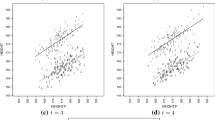Abstract
We consider a class of random effects models for clustered multivariate binary data based on the threshold crossing technique of a latent random vector. Components of this latent vector are assumed to have a Laird–Ware structure. However, in place of their Gaussian assumptions, any specified class of multivariate distribution is allowed for the random effects, and the error vector is allowed to have any strictly positive pdf. A well known member of this class of models is the multivariate probit model with random effects. We investigate sufficient and necessary conditions for the existence of maximum likelihood estimates for the location and the association parameters. Implications of our results are illustrated through some hypothetical examples.
Similar content being viewed by others
References
Albert A, Anderson J (1981) Probit and logistic discriminant functions. Commun Stat A 10: 641–657
Albert A, Anderson JA (1984) On the existence maximum likelihood estimates in logistic regression models. Biometrika 71: 1–10
Ashford JR, Sowden RR (1970) Multivariate probit analysis. Biometrics 26: 535–546
Catalano PJ, Ryan LM (1992) Bivariate latent variable models for clustered discrete and continuous outcomes. J Am Stat Assoc 87: 651–658
CPLEX Optimization (1992) CPLEX. Incline Village. CPLEX Optimization, Nevada
Dale J (1986) Global cross-ratio models for bivariate, discrete, ordered responses. Biometrics 42: 907–917
Demidenko E (2004) Mixed models: theory and applications. Wiley, New York
Demidenko E, Massam H (1999) Existence of the maximum likelihood estimate in variance components models. Sankhyā 61: 431–443
Farkas J (1902) Theorie der einfachen ungleichungen. J für die reine und angewandte Mathematik 124: 1–27
Laird NM, Ware JH (1982) Random-effects models for longitudinal data. Biometrics 38: 963–974
Lesaffre E, Kaufmann H (1992) Existence and uniqueness of the maximum likelihood estimator for a multivariate probit model. J Am Stat Assoc 87: 805–811
Liang KY, Zeger SL (1986) Longitudinal data analysis using generalized linear models. Biometrika 73: 13–22
Lindsay B (1995) Mixture models: theory, geometry and applications. Institute of Mathematical Statistics, Hayward
Muthén B (1979) A structural probit model with latent variables. J Am Stat Assoc 74: 807–811
Muthén B, Muthén L (1998–2004) Mplus [Computer software]. Muthén & Muthén, Los Angeles
Natarajan R, McCullogh C (1995) A note on the existence of the posterior distribution for a class of mixed models for binary responses. Biometrika 82: 639–643
Plackett RL (1965) A class of bivariate distribution. J Am Stat Assoc 60: 516–522
Prékopa A (1973) On logarithmic concave measures and functions. Acta Scientiarum Mathematicarum (Szeged) 34: 343–355
Robbins H (1956) An empirical bayes approach to statistics. Proc Third Berkeley Symp Math Stat Prob 1: 157–163
Silvapulle M (1981) On the existence of maximum likelihood estimates for binomial response models. J R Stat Soc B 43: 310–313
Speckman P, Lee J, Sun D (2000) Existence of the mle and propriety of posteriors for a general multinomial choice model. Tech. rep., Department of Statistics, University of Missouri-Columbia
Sun D, Tsutakawa RK, He Z (2001) Propriety of posteriors with improper priors in hierarchical linear mixed models. Stat Sinica 11: 77–95
Teicher H (1961) Identifiability of mixtures. Ann Math Stat 32: 244–248
Ten Have T, Morabia A (1999) Mixed effects models with bivariate and univariate association parameters for longitudinal bivariate binary response data. Biometrics 55: 85–93
Todem D, Kim K (2007) Existence and uniqueness conditions for the maximum likelihood solution in regression models for correlated Bernoulli random variables. J Math Stat 3(3): 134–141
Todem D, Kim K, Lesaffre E (2007) Latent-variable models for longitudinal data with bivariate ordinal outcomes. Stat Med 26: 1034–1054
Verbeke G, Molenberghs G (2000) Linear mixed models for longitudinal data. Springer, New York
Author information
Authors and Affiliations
Corresponding author
Rights and permissions
About this article
Cite this article
Todem, D., Kim, K. On the existence of maximum likelihood estimates in random effects models for clustered multivariate binary data. Metrika 73, 23–41 (2011). https://doi.org/10.1007/s00184-009-0263-2
Received:
Published:
Issue Date:
DOI: https://doi.org/10.1007/s00184-009-0263-2




